2007 CHEVROLET CORVETTE coolant temperature
[x] Cancel search: coolant temperaturePage 350 of 488
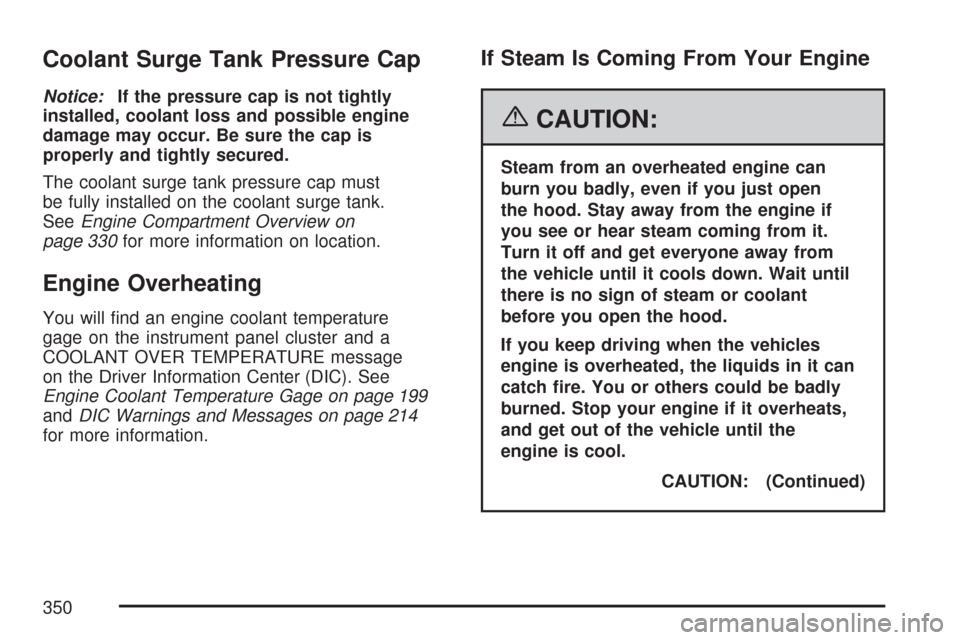
Coolant Surge Tank Pressure Cap
Notice:If the pressure cap is not tightly
installed, coolant loss and possible engine
damage may occur. Be sure the cap is
properly and tightly secured.
The coolant surge tank pressure cap must
be fully installed on the coolant surge tank.
SeeEngine Compartment Overview on
page 330for more information on location.
Engine Overheating
You will �nd an engine coolant temperature
gage on the instrument panel cluster and a
COOLANT OVER TEMPERATURE message
on the Driver Information Center (DIC). See
Engine Coolant Temperature Gage on page 199
andDIC Warnings and Messages on page 214
for more information.
If Steam Is Coming From Your Engine
{CAUTION:
Steam from an overheated engine can
burn you badly, even if you just open
the hood. Stay away from the engine if
you see or hear steam coming from it.
Turn it off and get everyone away from
the vehicle until it cools down. Wait until
there is no sign of steam or coolant
before you open the hood.
If you keep driving when the vehicles
engine is overheated, the liquids in it can
catch �re. You or others could be badly
burned. Stop your engine if it overheats,
and get out of the vehicle until the
engine is cool.
CAUTION: (Continued)
350
Page 352 of 488
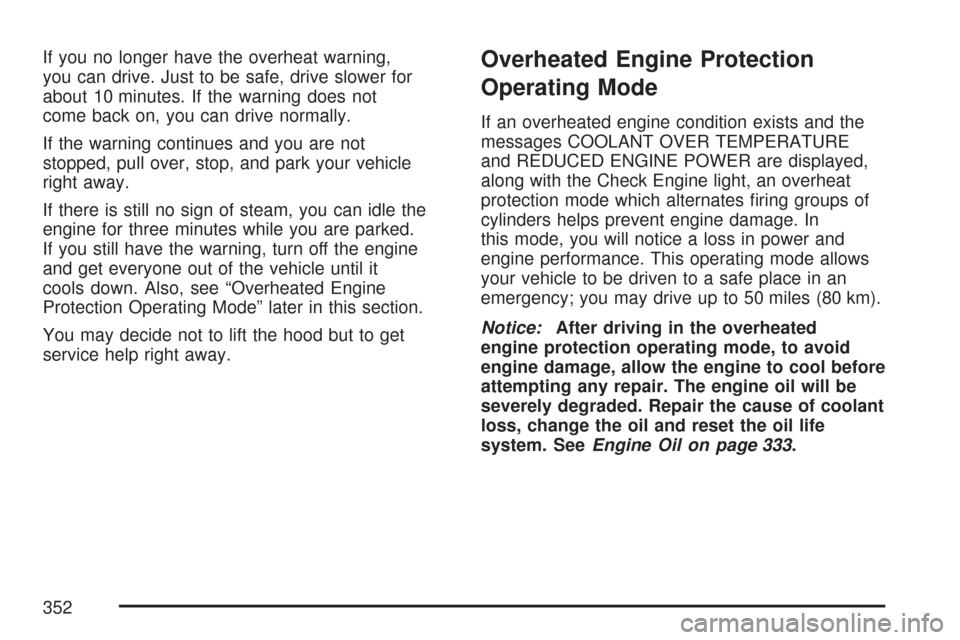
If you no longer have the overheat warning,
you can drive. Just to be safe, drive slower for
about 10 minutes. If the warning does not
come back on, you can drive normally.
If the warning continues and you are not
stopped, pull over, stop, and park your vehicle
right away.
If there is still no sign of steam, you can idle the
engine for three minutes while you are parked.
If you still have the warning, turn off the engine
and get everyone out of the vehicle until it
cools down. Also, see “Overheated Engine
Protection Operating Mode” later in this section.
You may decide not to lift the hood but to get
service help right away.Overheated Engine Protection
Operating Mode
If an overheated engine condition exists and the
messages COOLANT OVER TEMPERATURE
and REDUCED ENGINE POWER are displayed,
along with the Check Engine light, an overheat
protection mode which alternates �ring groups of
cylinders helps prevent engine damage. In
this mode, you will notice a loss in power and
engine performance. This operating mode allows
your vehicle to be driven to a safe place in an
emergency; you may drive up to 50 miles (80 km).
Notice:After driving in the overheated
engine protection operating mode, to avoid
engine damage, allow the engine to cool before
attempting any repair. The engine oil will be
severely degraded. Repair the cause of coolant
loss, change the oil and reset the oil life
system. SeeEngine Oil on page 333.
352
Page 360 of 488
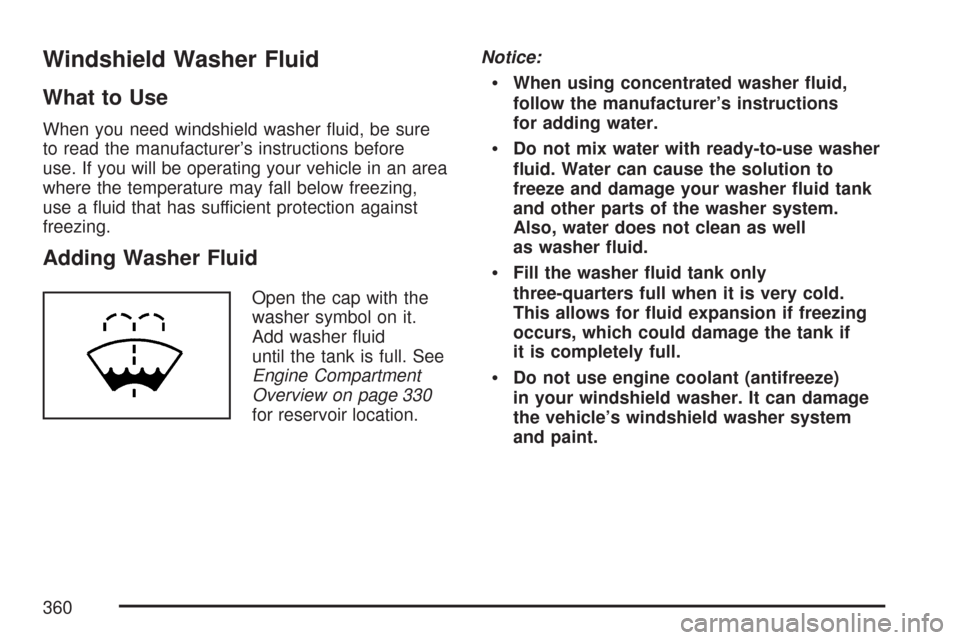
Windshield Washer Fluid
What to Use
When you need windshield washer �uid, be sure
to read the manufacturer’s instructions before
use. If you will be operating your vehicle in an area
where the temperature may fall below freezing,
use a �uid that has sufficient protection against
freezing.
Adding Washer Fluid
Open the cap with the
washer symbol on it.
Add washer �uid
until the tank is full. See
Engine Compartment
Overview on page 330
for reservoir location.Notice:
When using concentrated washer �uid,
follow the manufacturer’s instructions
for adding water.
Do not mix water with ready-to-use washer
�uid. Water can cause the solution to
freeze and damage your washer �uid tank
and other parts of the washer system.
Also, water does not clean as well
as washer �uid.
Fill the washer �uid tank only
three-quarters full when it is very cold.
This allows for �uid expansion if freezing
occurs, which could damage the tank if
it is completely full.
Do not use engine coolant (antifreeze)
in your windshield washer. It can damage
the vehicle’s windshield washer system
and paint.
360
Page 438 of 488

(h)Change automatic transmission �uid and �lter
if the vehicle is mainly driven under one or
more of these conditions:
�In heavy city traffic where the outside
temperature regularly reaches 90°F (32°C)
or higher.
�In hilly or mountainous terrain.
�Uses such as high performance operation.
(i)Drain, �ush, and re�ll cooling system.
This service can be complex; you should have
your dealer/retailer perform this service. See
Engine Coolant on page 347 for what to use.
Inspect hoses. Clean radiator, condenser, pressure
cap, and �ller neck. Pressure test the cooling
system and pressure cap.
(j)If you drive regularly under dusty conditions,
the �lter may require replacement more often.
(k)If you drive regularly under dusty conditions,
inspect the �lter at each engine oil change.
(l)Visually inspect belt for fraying, excessive
cracks, or obvious damage. Replace belt if
necessary.Owner Checks and Services
These owner checks and services should be
performed at the intervals speci�ed to help ensure
the safety, dependability, and emission control
performance of your vehicle. Your GM
Goodwrench
®dealer can assist you with these
checks and services.
Be sure any necessary repairs are completed at
once. Whenever any �uids or lubricants are added
to your vehicle, make sure they are the proper
ones, as shown inRecommended Fluids and
Lubricants on page 443.
438
Page 476 of 488
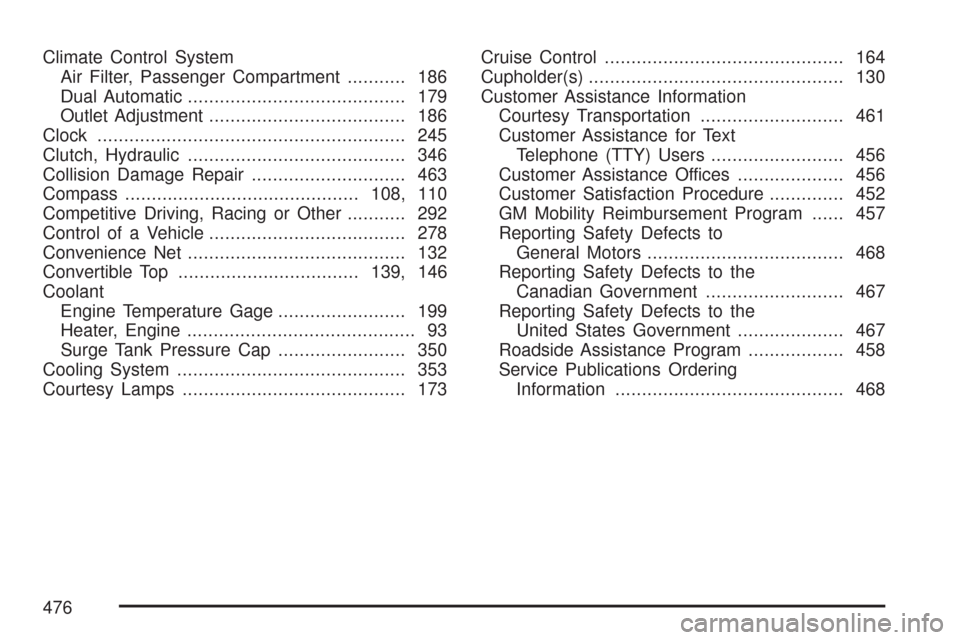
Climate Control System
Air Filter, Passenger Compartment........... 186
Dual Automatic......................................... 179
Outlet Adjustment..................................... 186
Clock.......................................................... 245
Clutch, Hydraulic......................................... 346
Collision Damage Repair............................. 463
Compass............................................108, 110
Competitive Driving, Racing or Other........... 292
Control of a Vehicle..................................... 278
Convenience Net......................................... 132
Convertible Top..................................139, 146
Coolant
Engine Temperature Gage........................ 199
Heater, Engine........................................... 93
Surge Tank Pressure Cap........................ 350
Cooling System........................................... 353
Courtesy Lamps.......................................... 173Cruise Control............................................. 164
Cupholder(s)................................................ 130
Customer Assistance Information
Courtesy Transportation........................... 461
Customer Assistance for Text
Telephone (TTY) Users ......................... 456
Customer Assistance Offices.................... 456
Customer Satisfaction Procedure.............. 452
GM Mobility Reimbursement Program...... 457
Reporting Safety Defects to
General Motors..................................... 468
Reporting Safety Defects to the
Canadian Government.......................... 467
Reporting Safety Defects to the
United States Government.................... 467
Roadside Assistance Program.................. 458
Service Publications Ordering
Information........................................... 468
476
Page 478 of 488
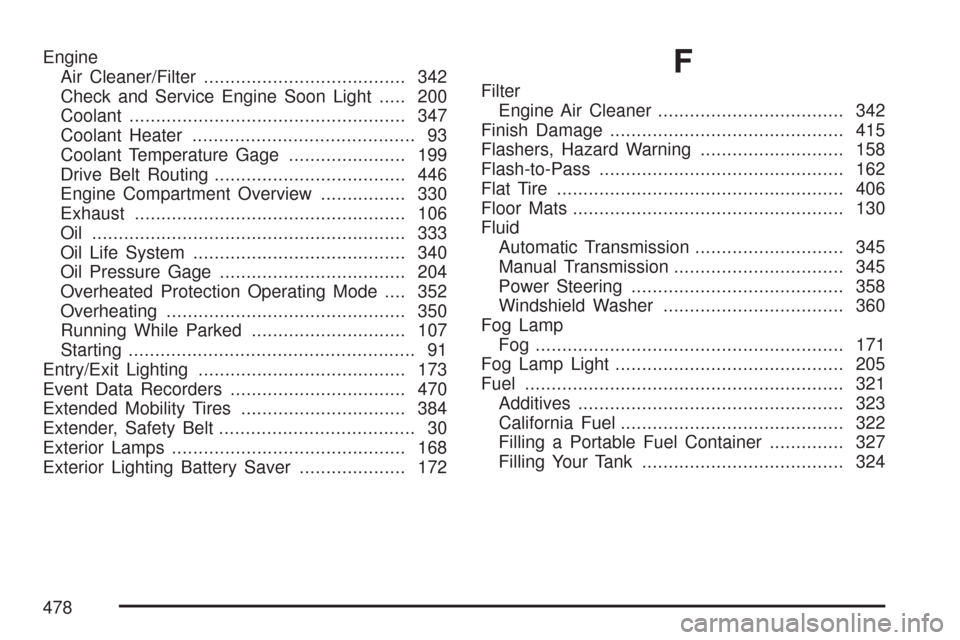
Engine
Air Cleaner/Filter...................................... 342
Check and Service Engine Soon Light..... 200
Coolant.................................................... 347
Coolant Heater.......................................... 93
Coolant Temperature Gage...................... 199
Drive Belt Routing.................................... 446
Engine Compartment Overview................ 330
Exhaust................................................... 106
Oil ........................................................... 333
Oil Life System........................................ 340
Oil Pressure Gage................................... 204
Overheated Protection Operating Mode.... 352
Overheating............................................. 350
Running While Parked............................. 107
Starting...................................................... 91
Entry/Exit Lighting....................................... 173
Event Data Recorders................................. 470
Extended Mobility Tires............................... 384
Extender, Safety Belt..................................... 30
Exterior Lamps............................................ 168
Exterior Lighting Battery Saver.................... 172F
Filter
Engine Air Cleaner................................... 342
Finish Damage............................................ 415
Flashers, Hazard Warning........................... 158
Flash-to-Pass.............................................. 162
Flat Tire...................................................... 406
Floor Mats................................................... 130
Fluid
Automatic Transmission............................ 345
Manual Transmission................................ 345
Power Steering........................................ 358
Windshield Washer.................................. 360
Fog Lamp
Fog .......................................................... 171
Fog Lamp Light........................................... 205
Fuel............................................................ 321
Additives.................................................. 323
California Fuel.......................................... 322
Filling a Portable Fuel Container.............. 327
Filling Your Tank...................................... 324
478
Page 479 of 488
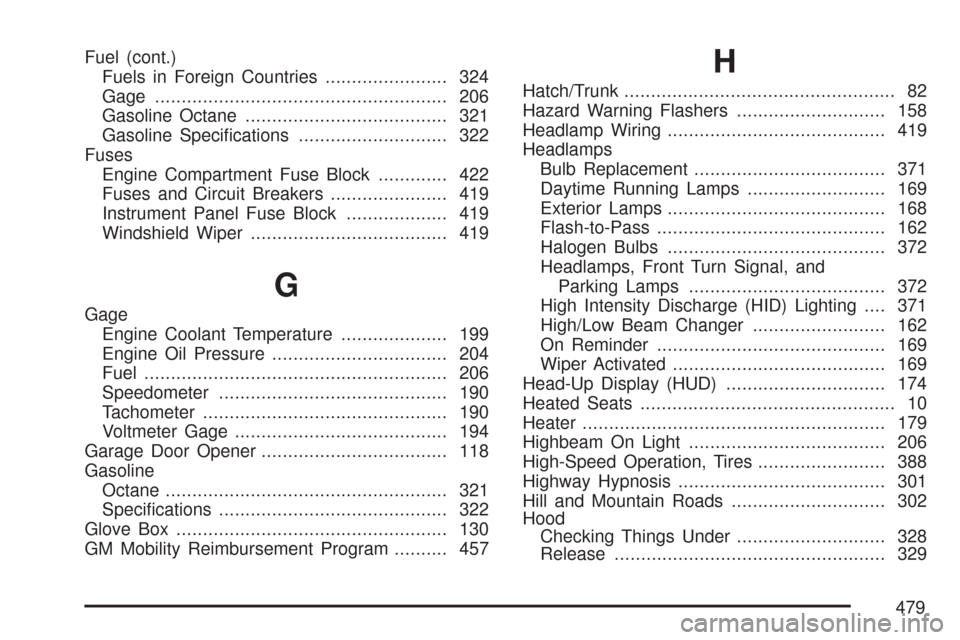
Fuel (cont.)
Fuels in Foreign Countries....................... 324
Gage....................................................... 206
Gasoline Octane...................................... 321
Gasoline Speci�cations............................ 322
Fuses
Engine Compartment Fuse Block............. 422
Fuses and Circuit Breakers...................... 419
Instrument Panel Fuse Block................... 419
Windshield Wiper..................................... 419
G
Gage
Engine Coolant Temperature.................... 199
Engine Oil Pressure................................. 204
Fuel......................................................... 206
Speedometer........................................... 190
Tachometer.............................................. 190
Voltmeter Gage........................................ 194
Garage Door Opener................................... 118
Gasoline
Octane..................................................... 321
Speci�cations........................................... 322
Glove Box................................................... 130
GM Mobility Reimbursement Program.......... 457
H
Hatch/Trunk................................................... 82
Hazard Warning Flashers............................ 158
Headlamp Wiring......................................... 419
Headlamps
Bulb Replacement.................................... 371
Daytime Running Lamps.......................... 169
Exterior Lamps......................................... 168
Flash-to-Pass........................................... 162
Halogen Bulbs......................................... 372
Headlamps, Front Turn Signal, and
Parking Lamps..................................... 372
High Intensity Discharge (HID) Lighting.... 371
High/Low Beam Changer......................... 162
On Reminder........................................... 169
Wiper Activated........................................ 169
Head-Up Display (HUD).............................. 174
Heated Seats................................................ 10
Heater......................................................... 179
Highbeam On Light..................................... 206
High-Speed Operation, Tires........................ 388
Highway Hypnosis....................................... 301
Hill and Mountain Roads............................. 302
Hood
Checking Things Under............................ 328
Release................................................... 329
479